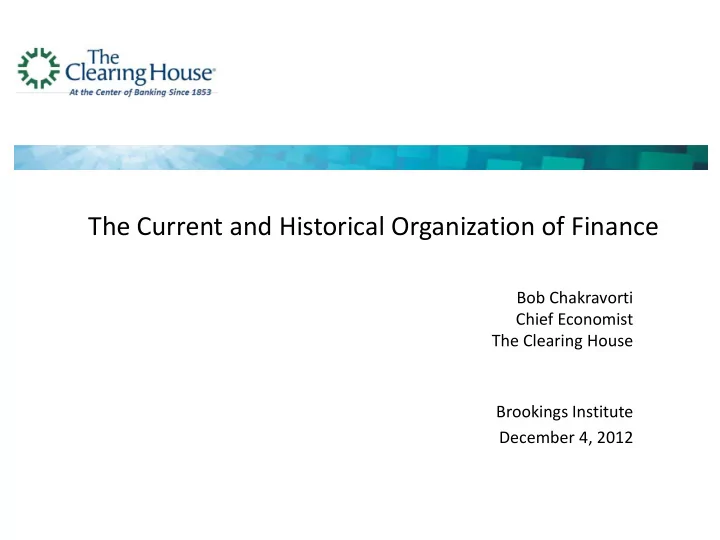

The Current and Historical Organization of Finance Bob Chakravorti Chief Economist The Clearing House Brookings Institute December 4, 2012
STRUCTURE AND CONCENTRATION OF BANKING MARKETS 2
U.S. banking system is relatively small compared to those of other developed countries In relation to the underlying economy it supports, the U.S. banking system is relatively small as compared to the banking systems of other developed countries Total Banking System Assets as a percent of GDP by Country (2011) 421% 373% 332% 258% 246% 240% 192% 180% 162% 144% 138% 117% 115% 112% 106% 94% 76% 71% 49% 42% 34% Source: Bank Indonesia, Bank of Canada, Bank of Japan, Bank of Korea, Board of Governors of the Federal Reserve System, Central Bank of Brazil, Central Bank of Turkey, China Banking Regulatory Commission, Comision Nacional Bancaria y de Valores de Mexico, Company filings, European Central Bank, International Monetary Fund, Reserve Bank of Australia, Reserve Bank of India, South African Reserve Bank, and Swiss National Bank. Note: Banking system assets generally refers to commercial banks, domestic credit institutions, and savings institutions, though definitions may moderately vary by country. 3
The U.S. banking industry is less concentrated than the banking systems of other countries By total assets, the five largest U.S. commercial banks are a smaller portion of total GDP than any of the other G7 nations Top 5 Banks by Assets as a percent of GDP by Country (2011) 309% 257% 179% 164% 149% 143% 126% 118% 116% 116% 105% 90% 87% 56% 55% 41% 40% 37% 31% 24% 18% Source: Board of Governors of the Federal Reserve System, Bank of Canada, Bank of Japan, Central Bank of Brazil, Central Bank of India, China Banking Regulatory Commission, European Central Bank, International Monetary Fund, Reserve Bank of Australia, and Swiss National Bank. Note: Top 5 Bank Asset data is as of the latest available reporting period as of December 31, 2011. Banks presented on a U.S. GAAP basis when available; otherwise, adjusted to exclude IFRS reported derivative assets for an estimated proxy for U.S. GAAP derivative netting rules. 4
The U.S. banking industry is less concentrated than other U.S. industries Of the industries that touch American’s lives everyday, the commercial banking system is less concentrated than numerous others including insurance providers, automobile manufacturers, and telecom providers Top 4 U.S. Firm Concentration by Revenue by Industry (2007) 90% 80% 71% 63% 57% 48% 39% 39% 37% 35% 32% 32% Computers Wireless Automobiles Pharmacies / Wired Petroleum Computer Aircraft Health Pharma Property / Commercial Telecom Drug Stores Telecom Software Insurance Casualty Banking Insurance Source: U.S. Census Bureau Note: Concentration defined as the sales, receipts, or revenue from the top 4 firms as a percent of the total sales, receipts, or revenue within the industry U.S. Census Bureau releases industry concentration data every 5 years with 2007 being the most recent release 5
ECONOMIES OF SCALE, SCOPE AND INNOVATION 6
To estimate benefits from economies of scale, for each product we calculate increase in unit costs associated with a maximum bank size. Product Unit Cost 1 Estimated breakdown of NIE $50 billion Subject to bank Subject to Average 80- no or few 10-20% Change economies bank over 90% economies in unit of scale $50 billion of scale cost 0 0 1 Product Reduction in bank size Volume (e.g., to $50 billion) SOURCE: SNL Financial; TCH large-bank study-participant data. 7
Technologies spread faster with the participation of large banks. Annual benefit Benefit over time Estimated benefits from large banks without large banks Time Technology Benefit duration inception 8
Benefits from large banks are distributed across product areas. Estimated annual benefits 1 Product areas $ Billions $20-45 $3-5 1. Retail banking $15-35 $15-30 $1-3 $10-20 2. Payments & clearing $4-8 $10-20 3. Commercial banking $3-10 $2-5 $2-4 4. Capital markets $5-15 $7-11 $2-4 $1-2 a. Economies b. Scope of c. Spread of scale products & of innovation 2 services Benefit category 1 Numbers may not sum due to rounding. 2 Based on analysis of historical benefit from spread of innovations over the past 30 years. SOURCE: TCH large-bank study-participant data. 9
TBTF, SYSTEMIC RISK, AND REGULATION 10
Recommend
More recommend